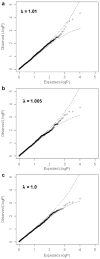Association study of 182 candidate genes in anorexia nervosa
- PMID: 20468064
- PMCID: PMC2963154
- DOI: 10.1002/ajmg.b.31082
Association study of 182 candidate genes in anorexia nervosa
Abstract
We performed association studies with 5,151 SNPs that were judged as likely candidate genetic variations conferring susceptibility to anorexia nervosa (AN) based on location under reported linkage peaks, previous results in the literature (182 candidate genes), brain expression, biological plausibility, and estrogen responsivity. We employed a case-control design that tested each SNP individually as well as haplotypes derived from these SNPs in 1,085 case individuals with AN diagnoses and 677 control individuals. We also performed separate association analyses using three increasingly restrictive case definitions for AN: all individuals with any subtype of AN (All AN: n = 1,085); individuals with AN with no binge eating behavior (AN with No Binge Eating: n = 687); and individuals with the restricting subtype of AN (Restricting AN: n = 421). After accounting for multiple comparisons, there were no statistically significant associations for any individual SNP or haplotype block with any definition of illness. These results underscore the importance of large samples to yield appropriate power to detect genotypic differences in individuals with AN and also motivate complementary approaches involving Genome-Wide Association (GWA) studies, Copy Number Variation (CNV) analyses, sequencing-based rare variant discovery assays, and pathway-based analysis in order to make up for deficiencies in traditional candidate gene approaches to AN.
(c) 2010 Wiley-Liss, Inc.
Figures
References
-
- Balding DJ. A tutorial on statistical methods for population association studies. Nat Rev Genet. 2006;7(10):781–791. - PubMed
-
- Barrett JC, Fry B, Maller J, Daly MJ. Haploview: Analysis and visualization of LD and haplotype maps. Bioinformatics. 2005;21:263–265. - PubMed
-
- Benjamini Y, Hochberg Y. Controlling the false discovery rate: A practical and powerful approach to multiple testing. J Royal Stat Soc Ser B. 1995;57:289–300.
-
- Benjamini Y, Drai D, Elmer G, Kafkafi N, Golani I. Controlling the false discovery rate in behavior genetics research. Behav Brain Res. 2001;125(1–2):279–284. - PubMed
Publication types
MeSH terms
Grants and funding
LinkOut - more resources
Full Text Sources
Other Literature Sources
Molecular Biology Databases


